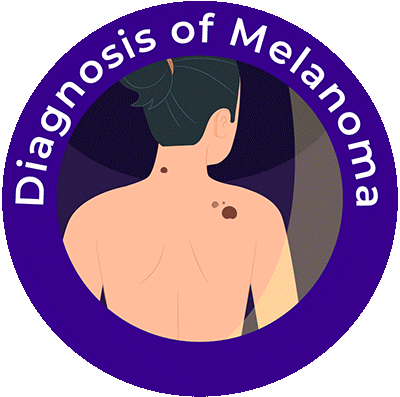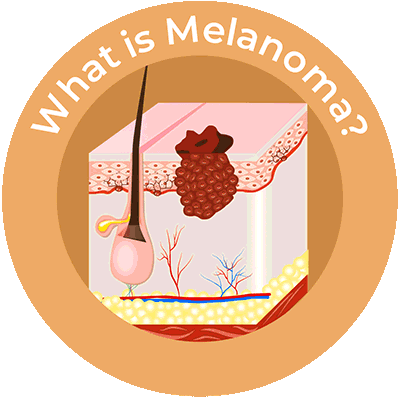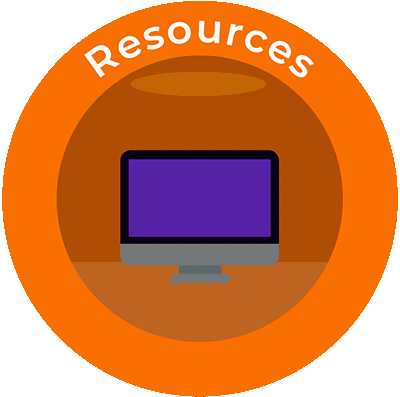This activity is provided by Med Learning Group.
This activity is supported by an independent medical education grant from Regeneron Pharmaceuticals, Inc.
Copyright © 2024 Med Learning Group. Built by Divigner. All Rights Reserved.
Diagnosis of Melanoma
Melanomas can be easily identified using the acronym ABCDE.1 Melanomas can itch, bleed, ulcerate, and develop satellites. Patients with metastatic disease will also have signs and symptoms related to the affected organ(s). During diagnosis, all lymph node groups must be evaluated.2 The mnemonic EFG (Elevated, Firm and Growing) is used in cases of nodular melanoma.3
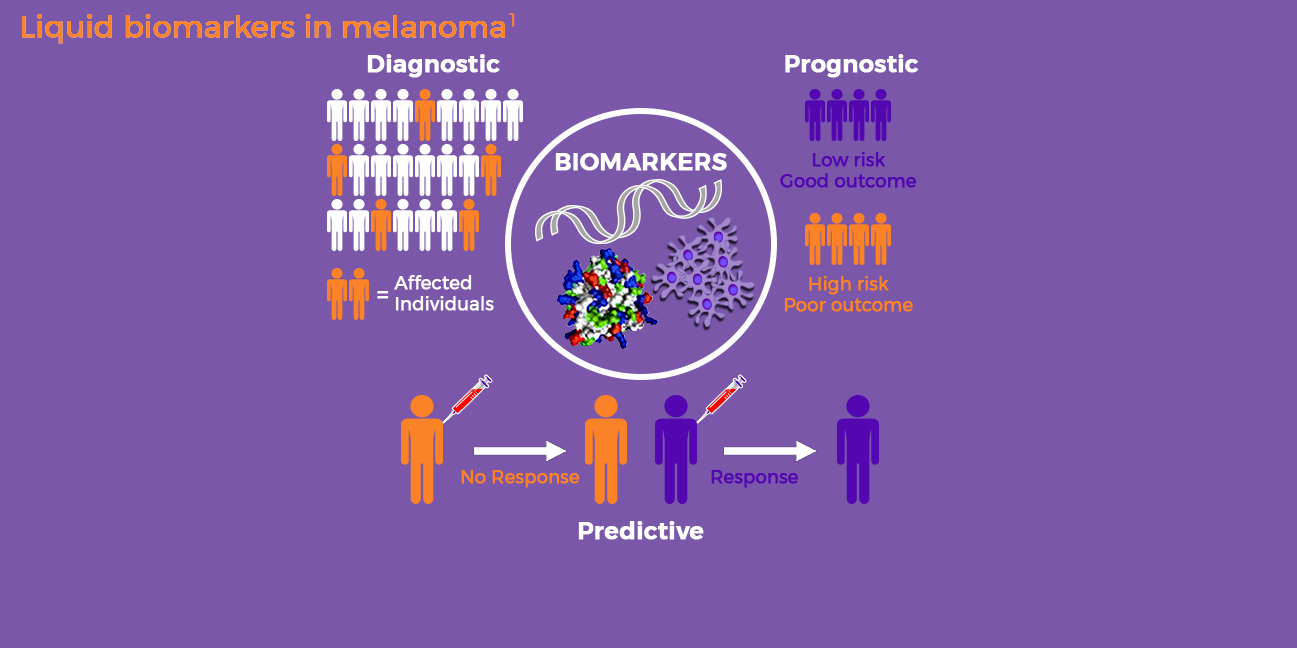
A comparative dermoscopic analysis and an excisional punch or shave biopsy is also used for diagnostic purposes. Newer types of biopsies such as reflectance confocal microscopy (RCM) can be done, and these do not require removal of skin samples.4 Histopathological parameters include histotype of melanoma, Brewslow thickness, Clark level, mitotic index, and the presence/absence of ulceration. In certain cases, immunohistochemical analysis is used to identify melanocytic (S-100 protein, Melan-A, HMB-45 or SOX10) and proliferation markers (MIB-1). Melanomas of a certain thickness can be assessed with a sentinel lymph node biopsy (SLNB) to determine the spread of the cancer to nearby lymph nodes.4
Lab tests on biopsy samples to confirm a melanoma diagnosis can include immunohistochemistry (IHC), fluorescence in situ hybridization (FISH), comparative genomic hybridization (CGH) and/or gene expression profiling (GEP). Melanoma staging is also performed, and this can drive treatment options and patient prognosis.4
Diagnosis can also involve one or more of the following tests3:
- Complete Blood Count (CBC)
- Chemistry panel including alkaline phosphatase, hepatic transaminases, total protein, albumin
- Lactate dehydrogenase
- Chest X-ray
- Brain MRI
- Ultrasound to diagnose lymph node involvement
- CT of the abdomen, chest, pelvis
- PET/PET-CT for other metastatic sites
Biomarkers in Melanoma Diagnosis and Treatment
There are 4 decision points during the diagnosis and treatment of melanoma where the use of biomarkers that can reduce uncertainty are being investigated. These include biopsy of a melanoma, histopathologic confirmation of diagnosis, stratifying risk by SLNB, and systemic therapy selection.5 Cellular, protein, and genetic markers can serve as diagnostic, prognostic, and/or predictive markers of cancer.6 The may prognostic and predictive biomarkers currently used clinically in melanoma form the updated version of the 8th edition American Joint Committee on Cancer (AJCC) melanoma staging system. This relies on tumor thickness, ulceration, and mitotic rate. Lactate dehydrogenase is the only circulating protein biomarker with significant prognostic value, and it correlates with poor survival in metastatic stage IV melanoma. A significant reduction in LDH is also associated with response to immunotherapy. While other proteins such as C reactive protein (CRP), S100B, and MIA have shown diagnostic and prognostic value, they have limitation in clinical use for melanoma.6

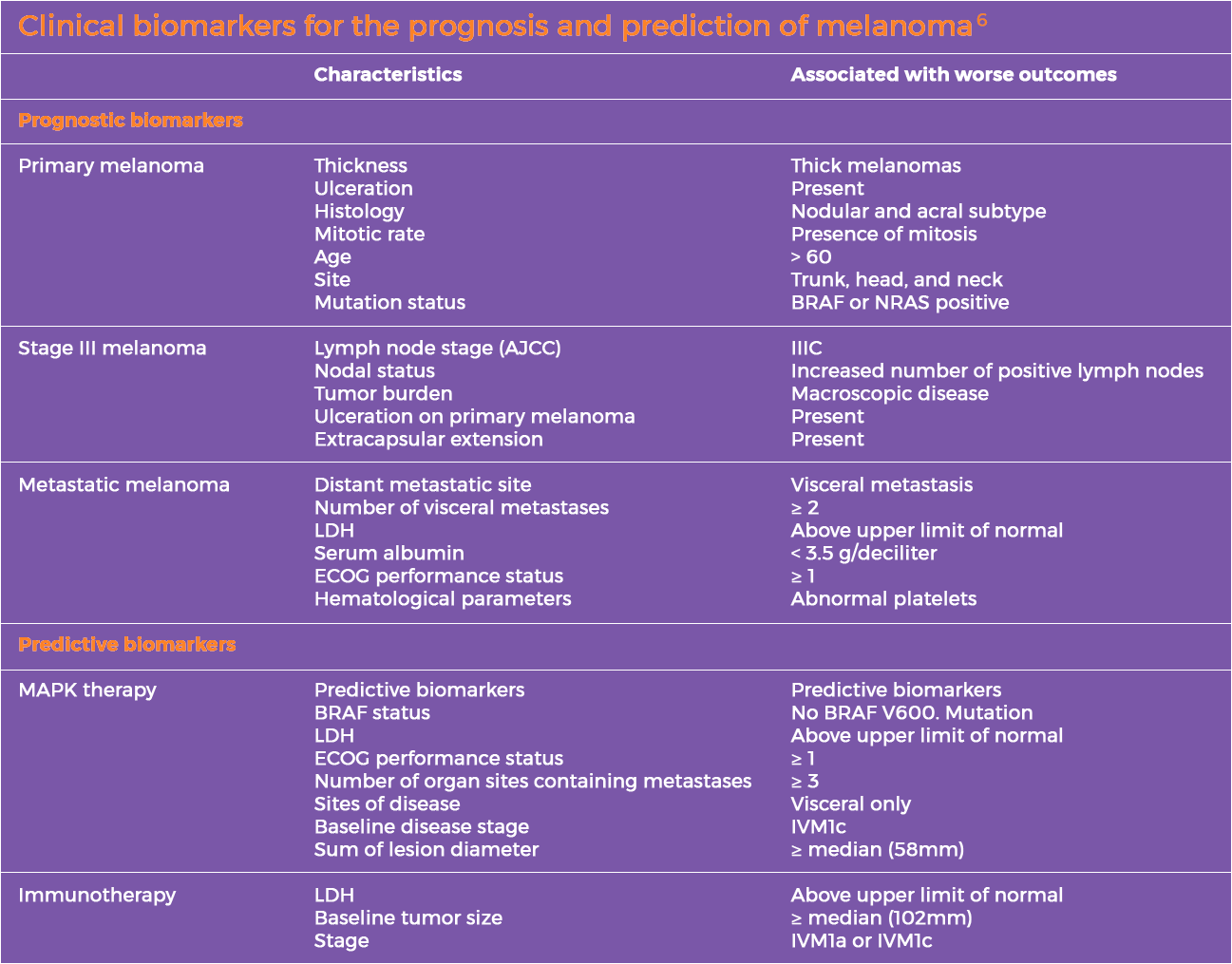
References
- Mayo Clinic. Melanoma. Symptoms and Causes. June 18, 2022. https://www.mayoclinic.org/diseases-conditions/melanoma/symptoms-causes/syc-20374884
- Heistein JB, Acharya U, Mukkamalla SKR. Malignant melanoma. In: StatPearls. Treasure Island (FL): StatPearls Publishing; July 4, 2022. https://pubmed.ncbi.nlm.nih.gov/29262210/
- American Cancer Society. Early detection, diagnosis, and staging. Last revised August 14, 2019. https://www.cancer.org/cancer/melanoma-skin-cancer/detection-diagnosis-staging/how-diagnosed.html
- Lopes J, Rodrigues CMP, Gaspar MM, Reis CP. Melanoma management: From epidemiology to treatment and latest advances. Cancers (Basel). 2022;14(19):4652. https://pubmed.ncbi.nlm.nih.gov/36230575/
- Deacon DC, Smith EA, Judson-Torres RL. Molecular biomarkers for melanoma screening, diagnosis, and prognosis: current state and future prospects. Front Med (Lausanne). 2021;8:642380. https://pubmed.ncbi.nlm.nih.gov/33937286/
- Lim SY, Lee JH, Diefenbach RJ, Kefford RF, Rizos H. Liquid biomarkers in melanoma: Detection and discovery. Mol Cancer. 2018;17(1):8. https://pubmed.ncbi.nlm.nih.gov/29343260/
All URLs accessed on January 9, 2023


